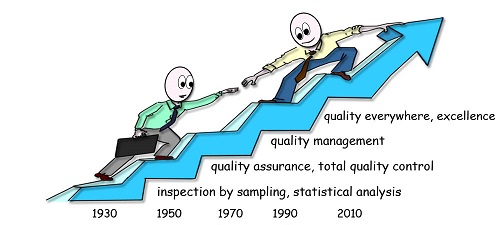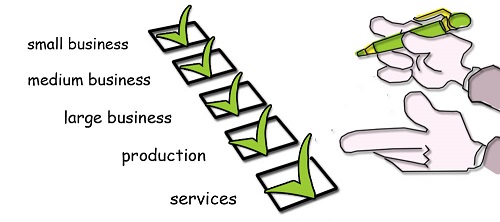1 Quality approach T 22
1.1 History and references
Quality evolution, medical devices and other standards and references
Other medical devices proverbs and quotes

Medicines and medical devicesproduct or service to be used for purposes of diagnosis, prevention, monitoring, treatment, alleviation of disease or injury have been used for millennia. The first industrialized and standardized medical deviceproduct or service to be used for purposes of diagnosis, prevention, monitoring, treatment, alleviation of disease or injury made its appearance in 1894. This is the all glass syringe, sterilizable, manufactured by the glass blower Eugène Fournier.
The Medical Devices Act (amendments to the Food, Drugs and Cosmetics Act) was introduced in 1976 in the United States of America.
The technical committee "Management and quality assurance" (ISO/TC 176) within the ISO (International Organization for Standardization) was created in 1980. ISO itself was created in 1947. ISO comes from the Greek "isos" (equal).
The first edition of the ISO 9000 family of standards appeared in 1987.
The first edition of the ISO 13485 standard appeared in 1996. The second edition is from 2003.
The text of ISO 13485 is based on ISO 9001: Quality Management Systems - Version 2008 – Requirements, mainly for the structure and adds specific requirements such as cleanliness of the product, control of contamination, installation activities, sterilization, traceability and complaint handling.
Two notable exceptions are customer satisfactiontop priority objective of every management system (see also ISO 9000, 3.9.2) (sub-clause 8.2.1) and continual improvementprocess allowing the improvement of the global performance of the organization (see also ISO 9000, 3.3.2) (sub-clause 8.5.1). The first point is replaced by "Feedback" (from the customer), which is less subjective and the second point is replaced by maintenance and not continual improvement of the management systemset of processes allowing objectives to be achieved (see also ISO 9000, 3.5.3), which is more appropriate with the regulation of medical devicesproduct or service to be used for purposes of diagnosis, prevention, monitoring, treatment, alleviation of disease or injury.
The ISO 13485 edition of 2012 incorporates the full text of the 2003 edition and adds Annexes ZA, ZB and ZC (informative) for the relationship between ISO 13485 and EU directives 90/385/CEE (active implantable medical devices), 93/42/CEE (medical devices) and 98/79/CEE (in vitro diagnostic medical devices).
The essential performance, safety, health and environmental requirements to which products placed on the market must comply are laid down in the abovementioned European Directives.
The latest version of ISO 13485 ("Medical Devices - Quality Management Systems - Requirements for Regulatory Purposes") was published in March 2016.
This version is based on the standard and the structure of the ISO 9001 version 2008. The new additions include:
- the rise of risk-based thinking. The term risk now appears 20 times
- new terms (such as risk management and life cycle) and new sub-clauses (such as medical device file and complaint handling)
- stronger documentary requirements (more than 20 mandatory procedures)
- the phrase "applicable regulatory requirements" now appears in most sub-clauses (more than 40 times)
The guide for understanding and applying ISO 13485 is available in English. The ISO / TC 210 expert group developed this guide: "ISO 13485: 2016 - Medical devices - A pratical guide".
In the fifth part of the Health Code "Health Products", in French, Book II: "Medical devices, in vitro diagnostic medical devices and other products and articles regulated in the interest of public health" are the legal clauses (L5211, L5212) and regulatory requirements (R5211, R5212, R5221 and R5222) for medical devicesproduct or service to be used for purposes of diagnosis, prevention, monitoring, treatment, alleviation of disease or injury.
The Decree of 3 March 2003, in French, fixes the lists of medical devicesproduct or service to be used for purposes of diagnosis, prevention, monitoring, treatment, alleviation of disease or injury subject to the obligation of maintenance and internal and external qualityaptitude to fulfill requirements (see also ISO 9000, 3.6.2) control.
ISO 14971 (2019): "Medical devices - Application of risk management to medical devices" and NF S99-170 (2013) in French: "Maintenance of medical devices - Quality management system for the maintenance and management of risks associated with the operation of medical devices" will help you identify hazardous situations and evaluate the risks associated with the manufacture of medical devicesproduct or service to be used for purposes of diagnosis, prevention, monitoring, treatment, alleviation of disease or injury.
The technical report ISO/TR 24971 (2020) "Medical devices - Guidance on the application of ISO 14971" provides guidance for the development, implementation and maintenance of risk management of medical devices (better understanding the requirements of ISO 14971).
The ISO / TR 20416 (2020) technical report "Medical devices - Post-market surveillance for manufacturers" contains recommendations to better control the safety, performance and usability of medical devices after their marketing.
Plenty of useful information and many publications (texts, forms, questions and answers, recommendations) on medical devicesproduct or service to be used for purposes of diagnosis, prevention, monitoring, treatment, alleviation of disease or injury can be found on the ANSM (National Agency for the Safety of Medicines and Health Products) website in French.
ISO 20417: 2021 "Medical devices - Information to be supplied by the manufacturer" defines the requirements for the identification and labeling of medical devices.
Guidelines and other information on medical devicesproduct or service to be used for purposes of diagnosis, prevention, monitoring, treatment, alleviation of disease or injury are periodically updated on the MEDDEV European Commission's Public Health website "New references of harmonized standards for Medical Devices" (OJ C262 of 30 August 2012).
ISO 15223-1 (2016), "Medical Devices - Symbols for use with labels, labelling and information to provide for Medical Devices - Part 1: General Requirements", identifies requirements for symbols used in the labeling of medical devicesproduct or service to be used for purposes of diagnosis, prevention, monitoring, treatment, alleviation of disease or injury, to ensure the correct and safe use of medical devices.
The ISO/DIS 13408-1 "Aseptic treatment of health products - Part 1: General requirements" specifies general requirements and provides guidance on the general scope of aseptic treatment.
The standard “ISO 15378 (2017) Primary packaging materials for medicinal products — Particular requirements for the application of ISO 9001:2015, with reference to good manufacturing practice (GMP)” specifies requirementsexplicit or implicit need or expectation (see also ISO 9000, 3.6.4) for a quality management system for packaging.
The European Commission adopts directives establishing the principles and guidelines of GMP (Good Manufacturing Practices) for medicinal products and similar products. Specific guidelines complying with these principles are published in the GMP guide, available on the European Commission's website: Volume 4 - Good Manufacturing Practice (GMP) guidelines.
IEC 62304 (2006) "Medical Device Software - Software Life Cycle Process" defines life cycle requirements for medical deviceproduct or service to be used for purposes of diagnosis, prevention, monitoring, treatment, alleviation of disease or injury software.
Directive 93/42 / EEC (medical devices) is replaced by Regulation (EU) 2017/745 which comes into force on May 26, 2021.
The standardized conditions for the marketing of safe products in the EU (conformity marking) are detailed in Decision No 768/2008 / EC.
The experimental standard XP S99-223 Medical devices - Management of the benefit / risk ratio was released in 2020 in French.
The Qualitiso site is rich in information on standards and tools related to medical devicesproduct or service to be used for purposes of diagnosis, prevention, monitoring, treatment, alleviation of disease or injury.
The Global Harmonization Task Force, now IMDRF website is rich in documents on audit practices, market evaluation and monitoring, quality systems and performance and clinical security of medical devices.
All of these references and many others can be ordered (in electronic or paper format) on the ISO website.
More than 28,000 standards (in English and other languages) are available free of charge at Public.resource.Org.
1.2 Scope
Scope of the ISO 13485 standard and requirements that can be excluded

The ISO 13485 standard applies to any companya structure that satisfies a need (regardless of size) manufacturing medical devicesproduct or service to be used for purposes of diagnosis, prevention, monitoring, treatment, alleviation of disease or injury in the field of design, development, production and servicing activities.
Some examples of medical devicesproduct or service to be used for purposes of diagnosis, prevention, monitoring, treatment, alleviation of disease or injury:
- medical gloves
- syringes
- thermometer
- implants and prostheses
- braces
- lumbar belts
- corrective eyewear
- condoms
- diagnostic software
The clothing of hospital care staff is not considered to be a medical deviceproduct or service to be used for purposes of diagnosis, prevention, monitoring, treatment, alleviation of disease or injury.
Some requirementsexplicit or implicit need or expectation (see also ISO 9000, 3.6.4) of clauses 6, 7 or 8 can be excluded. A justification is recorded. This is possible when:
- it does not affect, in any way, product service conformity related to:
- meeting customer requirements
- meeting applicable regulatory requirements
- it does not relieve top management of its responsibilities
- it is justified in the quality manual
The steps to obtain CE marking are:
- describe the product
- determine the classification of the product
- identify associated technical standards
- establish the essential requirements
- identify and evaluate risks
- submit an application for approval to a notified body
- conduct a clinical evaluation, if required
- establish the technical documentation
- make a CE declaration of conformity
- affix the CE marking
CE marking is compulsory for medical devicesproduct or service to be used for purposes of diagnosis, prevention, monitoring, treatment, alleviation of disease or injury placed on the market of the European Union.
